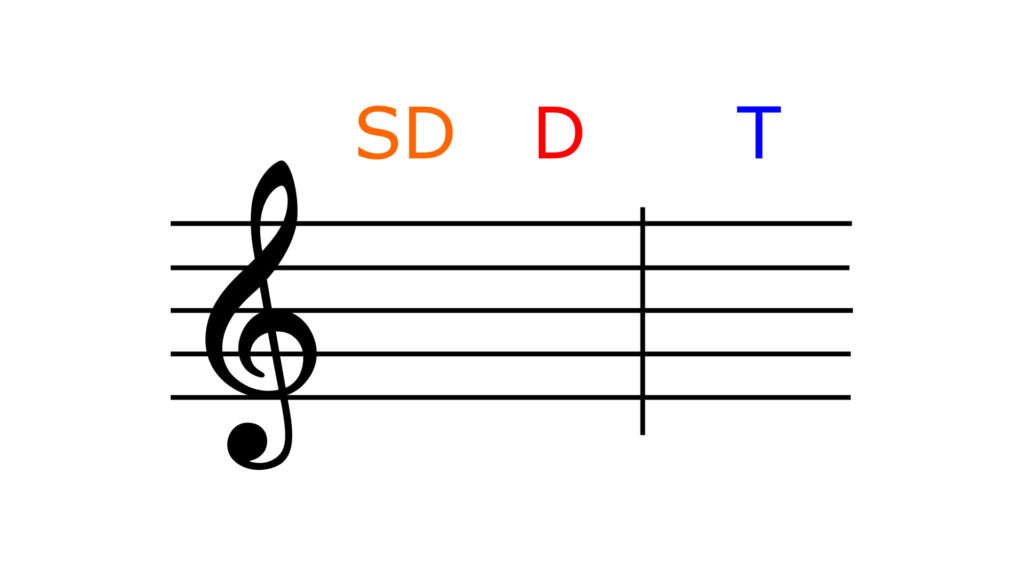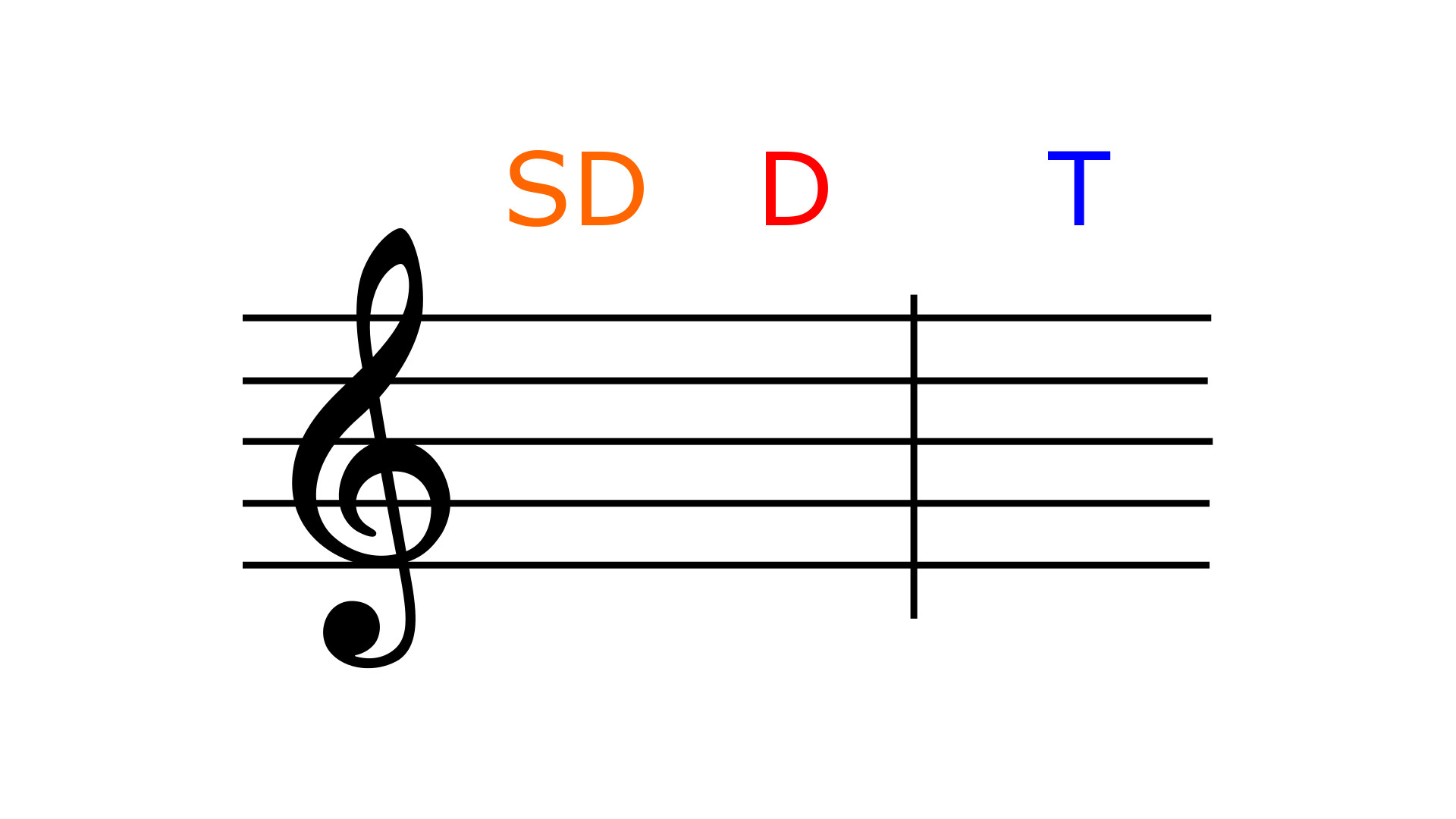When we refer to the tonal system we are taking into account a series of mechanisms that make it up, that give it meaning and that make tonal music sound exactly as it sounds. One of the key components of this musical system are the harmonic functions that are combined in it, the so-called tonal functions diatonic.
 Three tonal functions
Three tonal functions
Functional harmony
These functions are so important, so decisive for tonality as a sound organization that very often the tonal system is called functional harmony, making direct reference to those characteristic pieces or roles. This is a way of writing music and composing songs, the most common way in the West and the one that is usually studied in schools as an introduction to music theory.
What is a tonal function?
But before talking about each of them we should have some type of definition about what we mean by function in the context of tonal music. To explain it without technical words or literature, we can say that a tonal function is a perception, a musical sensation that we recognize when listening to a specific chord according to its location in a specific piece or passage. If we remember that practically all the songs and music we listen to provoke in us, upon listening to it, sensations of more or less tension or calm, certain degrees of expectation and a certain anticipation of what may happen during a piece, the tonal functions They describe those different sensations that we perceive.
The three main tonal functions
So, and although tonal music can reach a lot of degrees or strengths or tensions during its development, three large groups of chords or tonal functions are usually defined.
The tone The dominantThe subdominant
Each of them with a basic characteristic in the harmonic play of the tonal system.
Tonic Function
The tonic defines rest, the minimum tension, the chord or chords that, when we listen to them, cause us a feeling of rest, calm, of closure, to some extent. When we listen to a tonal composition, our ear will be expecting to hear, at some point and, especially, at the end of the musical sections or the work, a chord that resolves the ups and downs and tensions that have occurred during its interpretation. Although this does not always happen, and this is part of the expressive possibilities of music, the expectation, the longing for that rest, for that rounded ending will always be there, in our heads. It is also called the tonal center. The first chord or degree of a key will be the main representative of the tonic function.
Dominant Function
If the tonic is rest, then the dominant is tension. If the tonic invites stillness, the dominant calls for movement. That feeling of instability, that something else is missing and what we hear is incomplete, that is the function of the dominant. When we hear a chord that is quite dissonant but makes sense in musical development, when our ear is able to imagine a way out of that instability even before it is heard, it is very possible that we are hearing a dominant chord. The key for a chord to fulfill this dominant function is the so-called tritone, a particularly tense musical interval that usually resolves, or not, in the tonic of the key. The fifth chord or degree will be the main representative of the dominant function.
Subdominant Function
Between these two opposite poles of the tonal system, we find some chords that are neither stable nor very tense and that can lead us both towards the rest of the tonic and towards the tension of the dominant. With these versatile pieces we complete the game of tonality and, ultimately, the model that has spanned the history of music for more than 300 years, with extensions and derived ideas that have taken it far beyond what its seven notes and chords established in their basic form. Chords with a subdominant function allow us to enrich the development of musical ideas, prolong a harmonic progression or a cadence, for example, offering a respite in a tense passage or some strength and movement in a scene of calm or rest. All this, avoiding the direct swing between extremes and, ultimately, making the musical game more varied and interesting. The fourth chord or degree of a key will be the main representative of the subdominant function.
 Functions, the tonal gear
Functions, the tonal gear
Diatonic tonal functions
If we specify a little more which chords fulfill each specific tonal function, we must distinguish two common scenarios where they occur: major and minor keys.
Tonal functions (Major)
Tonic: I degree (major chord)Dominant: V degree (flat seventh chord)Subdominant: IV degree (major chord)
Tonal functions (minor)
Tonic: I degree (minor chord)Dominant: V degree (flat seventh chord)Subdominant: IV degree (minor chord) The rest of the chords of a key also fulfill one of these functions depending on the context in which they appear, but always with a lower strength than those we have mentioned.
Conclusions
You can see tonal functions as three different characters interacting and thus explaining a musical story, or as three environments for a stage or as three different colors that draw a song. The metaphor doesn't matter much, choose the one you prefer and use them to express your vision, to show what resonates in your head and wants to come out of your heart. As you can see, learning music is an exciting adventure. The tonal system is one of its most useful parts because most of the songs and melodies we hear every day are based on it. And the tonal functions explain the harmonic relationships that support it, so these lines serve as an introduction to the fascinating world of functional harmony. Listen to songs and music carefully and you will recognize their sound everywhere. #mailpoet_form_3 .mailpoet_form { } #mailpoet_form_3 .mailpoet_column_with_background { padding: 10px; } #mailpoet_form_3 .mailpoet_form_column:not(:first-child) { margin-left: 20px; } #mailpoet_form_3 .mailpoet_paragraph { line-height: 20px; margin-bottom: 20px; } #mailpoet_form_3 .mailpoet_segment_label, #mailpoet_form_3 .mailpoet_text_label, #mailpoet_form_3 .mailpoet_textarea_label, #mailpoet_form_3 .mailpoet_select_label, #mailpoet_form_3 .mailpoet_radio_label, #mailpoet_form_3 .mailpoet_checkbox_label, 3 .mailpoet_list_label, #mailpoet_form_3 .mailpoet_date_label { display: block; font-weight: normal; } #mailpoet_form_3 .mailpoet_text, #mailpoet_form_3 .mailpoet_textarea, #mailpoet_form_3 .mailpoet_select, #mailpoet_form_3 .mailpoet_date_month, #mailpoet_form_3 .mailpoet_date_day, #mailpoet_form_3 .mailpoet_date_year, #mailpoet_form_3 .mailpoet_date { display :block; } #mailpoet_form_3 .mailpoet_text, #mailpoet_form_3 .mailpoet_textarea { width: 200px; } #mailpoet_form_3 .mailpoet_checkbox { } #mailpoet_form_3 .mailpoet_submit { } #mailpoet_form_3 .mailpoet_divider { } #mailpoet_form_3 .mailpoet_message { } #mailpoet_form_3 .mailpoet_form_loading { width: 30px; text-align: center; line-height: normal; } #mailpoet_form_3 .mailpoet_form_loading > span { width: 5px; height: 5px; background-color: #5b5b5b; }#mailpoet_form_3{border: 1px solid #fcb900;border-radius: 40px;text-align: center;}#mailpoet_form_3 form.mailpoet_form {padding: 20px;}#mailpoet_form_3{width: 70%;}#mailpoet_form_3 .mailpoet_message {margin : 0; padding: 0 20px;}#mailpoet_form_3 .mailpoet_paragraph.last {margin-bottom: 0} @media (max-width: 500px) {#mailpoet_form_3 {background-image: none;}} @media (min-width: 500px) { #mailpoet_form_3 .last .mailpoet_paragraph:last-child {margin-bottom: 0}} @media (max-width: 500px) {#mailpoet_form_3 .mailpoet_form_column:last-child .mailpoet_paragraph:last-child {margin-bottom: 0}} Please leave this field emptyDo you write songs or would you like to?
I have read and accept the Privacy Policy With the Guide «The journey of a song» as a gift Check your inbox or spam folder to confirm your subscription.

